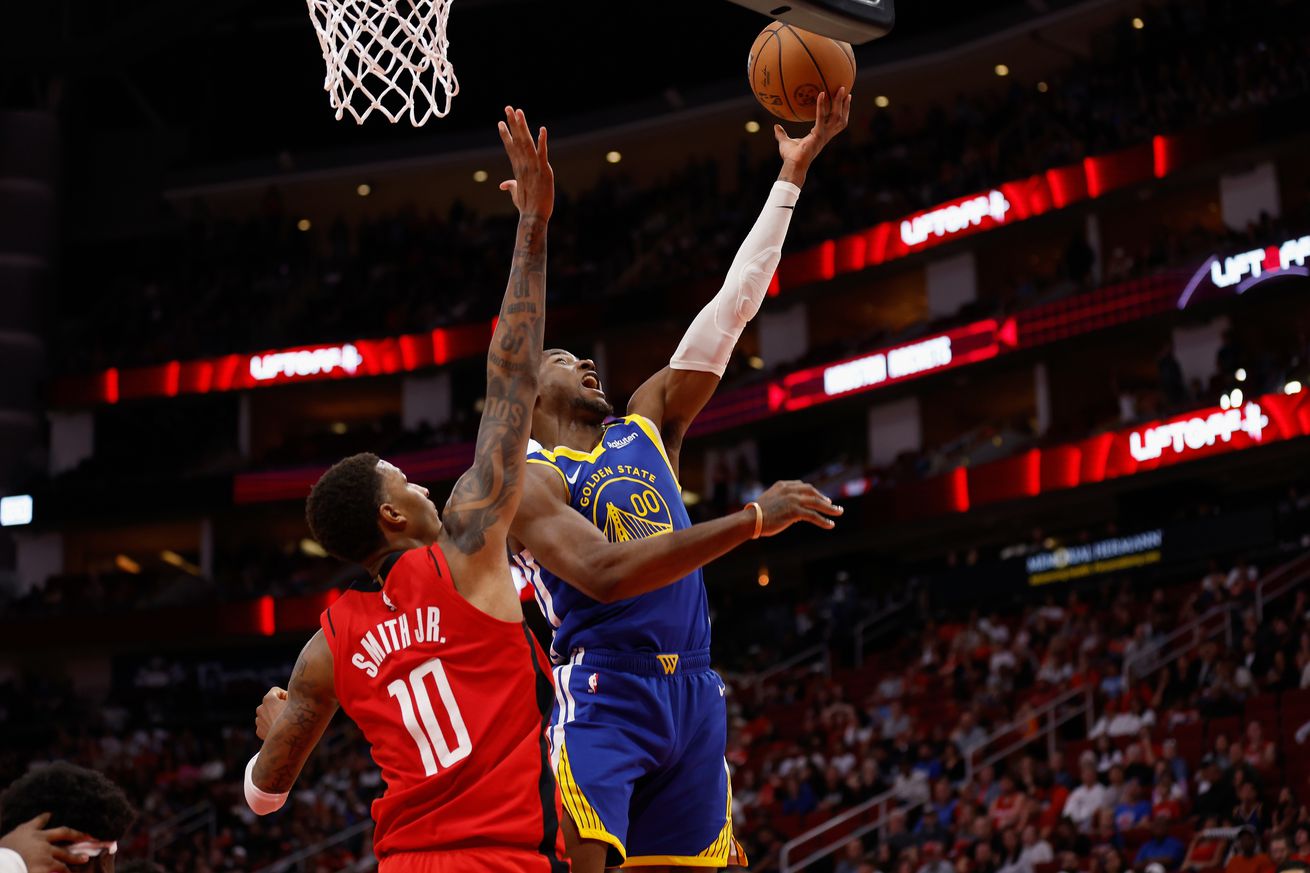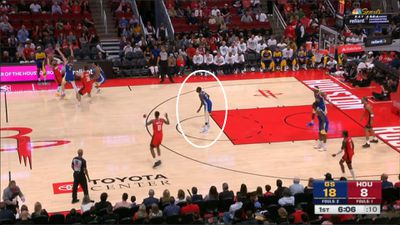
Despite blowing a 31-point lead — and without ball handlers and playmakers — Dubs lean on defense to survive.
If you pay attention to the lineups the Houston Rockets were throwing out late in the game against the Golden State Warriors, you’d notice quite the glaring absence: no Alperen Şengün, their up-and-coming center on an All-Star trajectory. Why then, you would ask, did the Rockets bench arguably their best player? The answer is simple: because the Warriors defense had completely taken away Şengün from the Rockets offense, all while highlighting his compromising presence on the defensive end for the Rockets.
Şengün played only 20 minutes and 38 seconds. While putting up 14 points on 5-of-10 shooting doesn’t seem like a damning stat line, the Rockets were outscored by seven points in those minutes. That doesn’t hold a candle to the 20 points they were outscored by during Jalen Green’s 33 minutes and 42 seconds, but a closer look at why the Rockets had a difficult time with their big man provides a clearer answer.
Consider the Warriors’ approach to playing defense under the guidance of assistant coach Jerry Stackhouse:

Brandin Podziemski and Trayce Jackson-Davis have Fred VanVleet corralled and trapped against the sideline. But more importantly, Draymond Green’s location is of note. He parks himself at the “nail” area (near the middle of the free throw line) to cover two possibilities:
- A short-roll pass to Şengün, who has a long runway ahead of him due to Green not being worried about his ability to shoot the ball.
- A skip pass to Jabari Smith Jr. on the weak-side slot — which is well within Green’s ability to intercept.
As such, having Şengün set the screens — especially whenever they’re set near the side — is an automatic trigger for the Warriors to send two to the ball, shore up behind the double, and let others not named Şengün or Green do the scoring or decision making. The Rockets’ lack of trusted decision making and screeners who can double as floor stretchers allows plenty of leeway for the Warriors to employ such aggressive coverages and is what helped them build a 71-47 halftime lead over the Rockets.
Fast forward to the 11-minute mark of the fourth quarter — during which the lead has trimmed down to 13 points, a miniscule number in today’s NBA. The Rockets have completely nailed Şengün to the bench and opted to send out their small lineup, which is not only switchable on the defensive end but also mobile and more versatile on offense. Furthermore, the nature of their ball-screen actions also changed, in the sense that it’s not a plodding 6’11” center with no floor-stretching capability setting it — it’s a 6’11” mobile four who can shoot the ball.
Theoretically, when it’s a small-to-small/wing pick-and-roll, such an action should be switched. Any two-to-the-ball coverage opens the possibility of a pop or ghosted screen drifting beyond the three-point line and leaving the screener wide open — as what happens below when Smith sets the screen for Aaron Holiday:
A wrongly chosen coverage by Jonathan Kuminga and Lindy Waters III leaves Smith open — and trims the lead to 10 points, one that would eventually dwindle to zero as the final buzzer of regulation sounded. What was once a 31-point lead was swept away, in huge part due to the Rockets’ personnel and ball-screen adjustment against the aggressive blitzes, and also due to the Warriors offense being stifled by the Rockets’ heavy switching.
As such, at the start of the overtime period, Steve Kerr chose to go with a lineup consisting of Podziemski, Andrew Wiggins, Kuminga, Kyle Anderson, and Kevon Looney. By virtue of the latter two being sent out, it was by no means a highly mobile lineup — but it still retained a considerable degree of switchability despite the absence of Draymond Green, who had fouled out in regulation. Nor was the frontcourt blessed with speed or pogo-stick athleticism — but Wiggins and Kuminga filling the wing slots provided them with just enough size and length to bother shots on defense while overpowering smaller and/or slower defenders on the other end. With no Stephen Curry and De’Anthony Melton available, Podziemski was counted on to be the ball handler and main decision maker on the floor.
As such, after a Smith miss from three to open overtime, look at how the Warriors attack the Rockets’ switch-everything scheme — glimpses of which were seen in regulation, where Kuminga and Wiggins found themselves with favorable matchups and proceeded to attack them with vigor:
When Kuminga finally gets the matchup he wants in Jalen Green, he backs him up closer to the paint and — despite a last-second help and contest by Amen Thompson — manages to create enough room for a turnaround fader.
That’s not to say the Warriors were blessed with a couple of fortunate Rockets misses. What should’ve been a clear switch turns into a VanVleet open three that misses — which the Warriors fail to haul in, giving up one of 18 offensive boards the Rockets tallied, equivalent to 35.4% of their misses. Another miss by Smith bails the Warriors out and Looney records the defensive rebound this time — allowing Kuminga to run the floor:
Another snag hits the Warriors soon after. With Podziemski fouling out, Kerr runs out of ball handlers and decision makers. He’s left with no choice but to send in Buddy Hield in Podziemski’s place. Despite Hield’s lack of ball-handling and playmaking — and having developed a reputation for being a subpar defender, if not “just okay” — he locks in and does his job when Jalen Green hunts him on a switch.
(Capped by a classic Slo-mo eurostep from Anderson):
Out of a timeout, the Warriors fail to get Kuminga a favorable one-on-one matchup. Smith ends up guarding him on the perimeter — but Kuminga catches Smith leading out with his right foot. Smith does an admirable job trying to mobilize his hips in time to stay in front, but Kuminga proves too quick and turns the corner for the layup.
Despite the absence of what typically makes the Warriors’ offense tick (Curry, ball-handling, connectors) and what typically holds their defense together (Draymond Green), the Warriors were able to squeeze in just enough offense to gain separation from the Rockets — and avert disaster that was commonplace last season. Defense has been their calling card to start this very young season, and it was defense that sealed the deal for them against the Rockets.
The refusal to bend at the point of attack and put themselves in a state of dire rotation has been a point of emphasis — and it was clearly emphasized below:
Despite the near collapse, the Warriors still find themselves second in the league in terms of points allowed per 100 possessions (101.0), just behind the Oklahoma City Thunder (95.1). They still top the league in deflections per game (23.0) and total deflections (138), although their lead in both categories has dwindled. Nevertheless, after seasons where identities were hard to come by and constant shuffling of personnel were often death knells, it’s a nice change of pace to see this iteration of the roster shore up in the face of adversity, all by shoring up their defensive intensity in a timely manner.